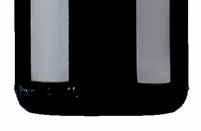
4 minute read
Amaro
AMARO BY LINDA GARSON
raditionally served after a meal to aid digestion, and alleviate that bloated and stuffed feeling when you’ve overindulged, amari (the plural of amaro) are made from herbs, flowers, roots, and bark, macerated in alcohol, and can be aged in barrels or in the bottle.
Advertisement
Meaning “bitter” in Italian, amari are becoming popular in Alberta as a brown after-dinner sipping drink, but these complex, sweetly bitter, herbal liqueurs are perfect for mixing in any number of cocktails:
Try as a spritz using a 3-1-1 recipe: three parts prosecco, one part amaro, and one part soda water.
They also make a wonderful Black Manhattan with 2 parts bourbon to 1 part amaro, and a maraschino cherry for garnish.
Make an amaro negroni with 1 part gin, 1 part Campari, and 1 part amaro instead of the sweet vermouth, and stir over ice. Garnish with orange peel.
Or just serve well chilled—with ice if you like—and a twist of lemon or orange peel.
A little goes a long way! While traditionally Italian, with the surge of craft spirits, many quality amari are being produced around the world, including Alberta. Here are a few that are highly recommended. T
Nonino Amaro Quintessentia Fruili, Italy Nonino’s grappa is infused with liquorice, rhubarb, saffron, sweet orange, and tamarind, as well as nearby Alpine roots and spices, and aged in barrels for five years when it develops an alluring burnt orange flavour. Sip slowly. CSPC +707179, $50
Venti L-Amaro Italiano, Italy The all-Italian amaro; Venti means “twenty” in Italian and one botanical is chosen from each of the 20 regions of Italy, and then blended to produce this aromatic and emotive sipper. CSPC +820748, $50
Vecchio Amaro del Capo Calabria, Italy 29 herbs, roots, flowers, and fruits are blended to create Vecchio amaro. Flavours of sweet orange blossom mingle with anise and mint for a bittersweet, and well balanced, after dinner digestif. CSPC +801961, $36–41
Amaro Tosolini, Fruili, Italy Of the 15 botanicals steeped in Eau de Vie in ash wood barrels, you’ll taste gentian, star anise, cloves, mint, and ginger, alongside wormwood, Seville oranges and lemon balm. Perfect for a spritz! CSPC +795127, $40–$44
Casoni Heritage Amaro Emilia Romagna, Italy A sweet, yet earthy, nose comes from blending orange, cardamom, St John’s Wort, and wormwood together with 16 more botanicals. A slightly sweeter style, this amaro would make a great Negroni. CSPC +829191, around $35
Amaro Meletti, Le Marche, Italy A rich and complex nose of caramel follows through onto the palate, with a long aftertaste of brown sugar. Meletti Amaro would be ideal in your coffee, or try in a Black Manhattan cocktail. CSPC +810007, $35
Wild Life Distillery Wildcat Amaro Canmore, Alberta Wild Life have infused their vodka with citrus peels, vanilla, mint, wormwood, gentian, and cacao, then blended it with Fallentimber’s mead for this bittersweet amaro—idea for a Rocky Mountain spritz! CSPC +823121 500 mL $37
Bridgeland Distillery Spolumbo’s Amaro, Calgary, Alberta Bitter chocolate and vanilla appear after an initial anise aroma, giving way to caramel and fennel in this California wine-based amaro. Named for five Calgary entrepreneurs; sip or try in a Black Manhattan. CSPC +828642, 500 mL $45
Introducing SANTA MARGHERITA CABERNET SAUVIGNON from the producers of the #1 Selling Pinot Grigio in Canada Santa Margherita S.p.A. Via Ita Marzotto, 8 30025 Fossalta di Portogruaro (VE) Tel. +39 0421 246 111 Fax +39 0421 246 417 www.santamargherita.com santamargherita@santamargherita.com Pinot Grigio 150 - 300 m (492 - 655 ft.) above sea level Of fluviatile origin; medium texture with stones Santa Margherita was the first company to vinify pink Pinot Grigio grapes as a white wine. In this process, the must does not remain in contact with the skins, from which it would otherwise take on the rusty color. Following a soft pressing, the must ferments for 10-15 days at 18 °C (64°). Once the fermentation is over, the wine is stored at a controlled temperature of 15 - 16 °C (59 - 61 °F) in stainless steel tanks until it is time to bottle. Santa Margherita S.p.A. Via Ita Marzotto, 8 30025 Fossalta di Portogruaro (VE) Tel. +39 0421 246 111 Fax +39 0421 246 417 www.santamargherita.com info@santamargherita.com Valdobbiadene Prosecco Superiore DOCG Brut
Glera PRODUCTION
Valdobbiadene ALTITUDE: 300 – 500 m (985 – 1,640 ft.) above sea level TYPE OF SOIL: Morainic origin, with little depth Sylvoz NTING
1,800 - 3,500 vines per hectare (730 – 1,415 per acre) HARVEST PERIOD: Second half of September ALCOHOL LEVEL: 11,50 % vol. TEMPERATURE: 8 - 10 °C (46 - 50 °F) RECOMMENDED Medium-sized, tulip-shaped glass, narrowing at the rim AGING POTENTIAL: 2 - 3 years TECHNICAL INFORMATION The base wine is put into pressurized tanks for the prise de mousse. There it ferments for 18-20 days, with the aid of selected yeasts, at a controlled temperature of 14-16 °C (57-61 °F). When the desired pressure has been obtained (around 6 bars), the wine is chilled to - 4° C in order to arrest the fermentation and encourage stabilization. The sparkling wine is then kept at a controlled temperature of 8-10 °C (46-50 °F) for at least a month, in order to favor its natural maturation in contact with the yeasts that have deposited on the bottom of the pressurized tank. At the end of this phase, filtration and isobaric bottling is carried out. Valdobbiadene Prosecco Superiore Brut Santa Margherita S.p.A. Via Ita Marzotto, 8 30025 Fossalta di Portogruaro (VE) Tel. +39 0421 246 111 Fax +39 0421 246 417 www.santamargherita.com info@santamargherita.com Cabernet Sauvignon Tending to clay, fluvial and lagoon origin Broad-bowled, narrowing towards the rim The harvested grapes are crushed and destemmed before red-wine vinification with 12-14 days’ skin contact at a temperature of 24-26 °C. Malolactic fermentation is followed by maturation partly in steel and partly in French

Santa Margherita Wines Santamargheritawines









